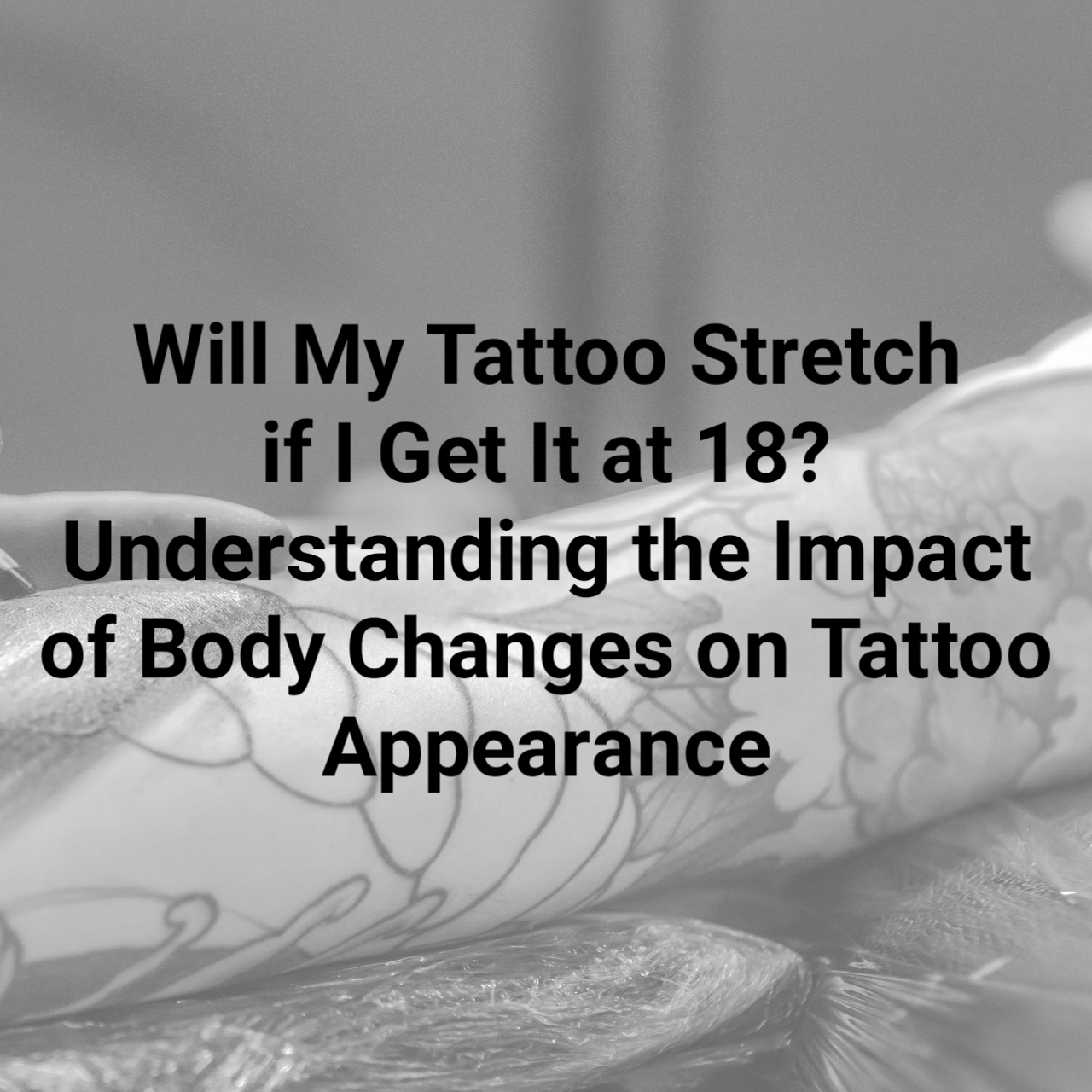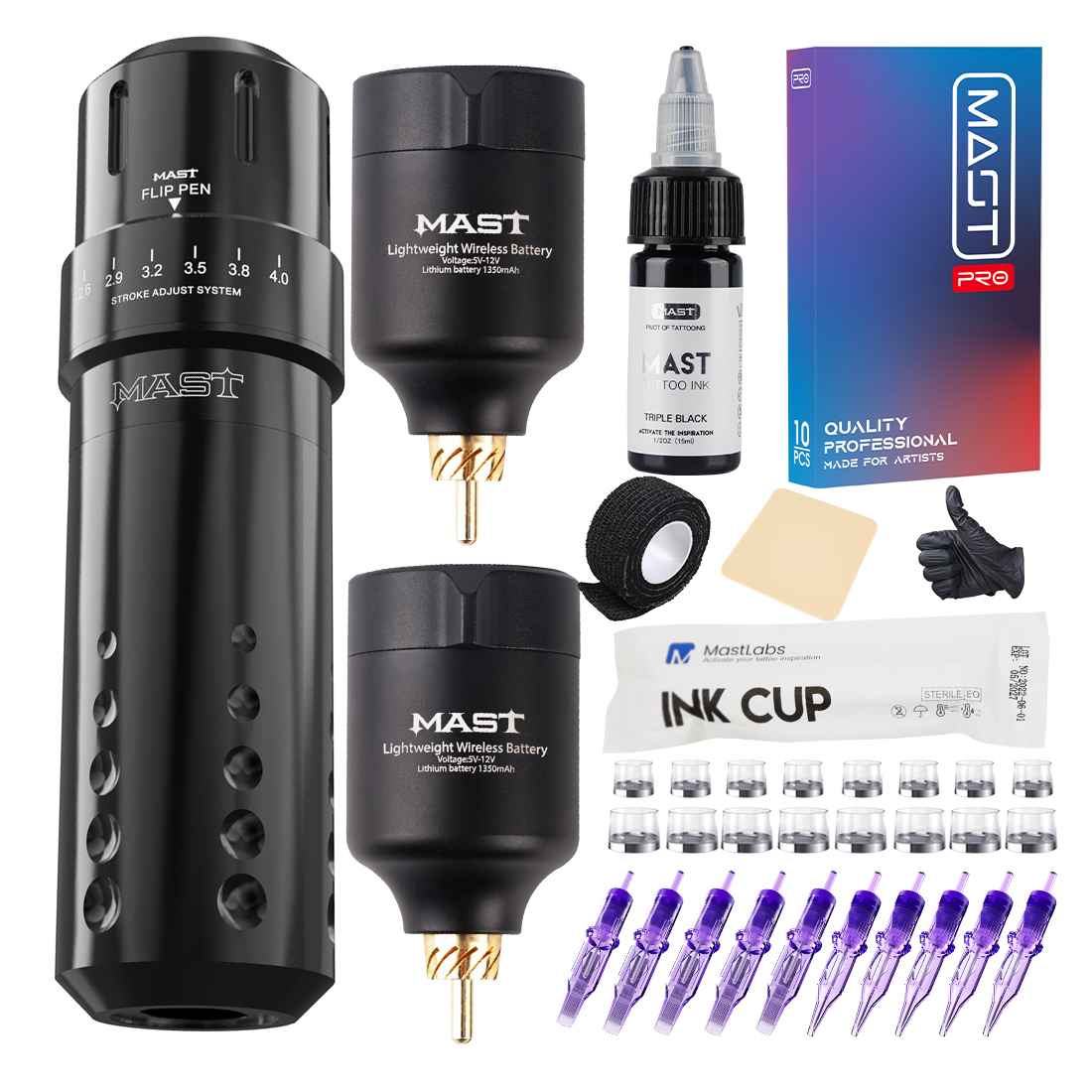In the world of body art, one question that frequently arises among tattoo enthusiasts is, “Will my tattoo stretch if I get it at 18?”
It’s a valid concern, as our bodies undergo changes over time that may affect the appearance of our tattoos.
In this blog post, we delve into the intriguing topic of tattoo stretching, shedding light on the factors and considerations involved.
According to a survey conducted by Pew Research Centre, nearly 40% of individuals aged 18-29 have at least one tattoo.
With such a significant portion of young adults embracing body art, it becomes crucial to address the potential effects of body changes on tattoo appearance.
Tattoo stretching refers to the distortion or alteration of a tattoo’s shape and clarity due to various factors, including weight gain, pregnancy, and muscle development.
Placement also plays a role, as certain areas of the body are more prone to stretching.
Throughout this blog post, we will explore how body changes can impact the appearance of tattoos, offering insights on placement choices, the role of a skilled tattoo artist, and tips to minimize stretching.
By understanding these factors, you can make informed decisions when getting a tattoo at 18, ensuring that your body art retains its beauty and integrity for years to come.
Understanding Tattoo Stretching
Tattoos are not only artistic expressions on the skin but also personal statements that hold sentimental value.
However, as our bodies change over time, tattoos may undergo a transformation of their own.
What is Tattoo Stretching?
Tattoo stretching refers to the phenomenon where a tattoo design becomes distorted or elongated due to changes in the surrounding skin and underlying body tissues.
As our bodies go through various natural processes, such as growth, weight fluctuations, or muscle development, the skin expands or contracts, potentially affecting the appearance of tattoos.
Understanding this process is essential for individuals with tattoos, as it allows them to anticipate and manage potential changes.
Also Read: How old do I have to be to get a tattoo?
Factors Contributing to Tattoo Stretching
Let’s take a look at some factors that contribute to tattoo stretching;
1. Weight Gain
When an individual gains weight, the skin naturally stretches to accommodate the increased body mass.
This stretching can affect the appearance of tattoos, particularly if they are located in areas prone to significant weight fluctuations, such as the abdomen, thighs, or upper arms.
the degree of tattoo distortion may vary depending on the amount and speed of weight gain.
2. Pregnancy
Pregnancy is a transformative journey for the body, often accompanied by weight gain and significant hormonal changes.
As the abdomen expands to accommodate the growing fetus, the skin stretches, potentially altering the appearance of tattoos in that area.
Additionally, post-pregnancy weight loss can further impact the stretched skin and the tattoo within it.
3. Muscle Development
Engaging in regular strength training or bodybuilding exercises can lead to muscle growth and definition.
While this is a positive change for many individuals, it can affect tattoos in specific areas.
As muscles develop and expand, the surrounding skin may stretch, potentially distorting tattoos.
Common areas affected by muscle development include the biceps, chest, and thighs.
Also Read: Can you be 14 to get a tattoo?
Tattoo Placement and Stretching
When considering getting a tattoo, it’s not only essential to ponder the design and meaning but also to contemplate the long-term effects of tattoo placement.
One crucial factor to consider is how certain areas of the body are prone to stretching and distortion over time.
The Relationship Between Tattoo Placement and Stretching
Tattoos are a form of art etched onto our skin, which is a dynamic organ that can change shape and elasticity with age, weight fluctuations, and certain life events.
Understanding the relationship between tattoo placement and stretching is crucial for ensuring the long-term appearance and integrity of your ink.
Areas Prone to Stretching and Distortion
The common areas prone to tattoos stretching and distortion include;
1. Abdomen
The abdomen is a prime example of an area prone to significant stretching.
Factors such as weight gain, pregnancy, and muscle development can lead to considerable changes in the abdominal region.
If a tattoo is placed directly on the abdomen, it may undergo distortion and stretching, potentially altering the original design and proportions.
2. Thighs
The thighs are another area of the body susceptible to stretching, particularly in cases of weight gain or loss.
As the skin expands or contracts, tattoos on the thighs may become distorted, causing the artwork to lose its original shape and definition.
3. Upper Arms
The upper arms are commonly chosen for tattoos, but they are also subject to changes in muscle tone and size.
If the biceps or triceps muscles grow or shrink significantly, tattoos in this area may stretch or contract, resulting in a distorted appearance.
Also Read: Is it okay to have a tattoo at 16?
Factors to Consider for Long-Term Tattoo Placement
Planning out your tattoo placement is very essential as we’ve seen how it can affect tattoo stretching. It is therefore important to not take it lightly.
Here are some of the factors to consider for long term tattoo placement;
1. Future Body Changes
Before deciding on a tattoo placement, consider potential future body changes.
Reflect on your lifestyle, any weight fluctuations you may experience, and how these changes might affect the appearance of your tattoo over time.
2. Alternative Placement Options
If you have concerns about potential stretching or distortion, consider alternative placement options.
For example, instead of placing a tattoo directly on the abdomen, you might opt for the rib cage or the side of the waist, which are less prone to significant stretching.
3. Consultation with a Tattoo Artist
Seek the expertise of a skilled tattoo artist during the design and placement process.
A professional artist will understand the body’s dynamics and provide recommendations based on your desired design and long-term goals.
Also Read: Is 17 a good age to get a tattoo?
Body Changes and Tattoo Appearance
One aspect often overlooked when contemplating a tattoo is how various body changes can affect the appearance of the tattoo over time.
It’s important to consider how weight fluctuations, pregnancy, and muscle development can potentially impact the tattoo and its original design.
1. Weight Fluctuations
Weight fluctuations, whether through weight gain or weight loss, can significantly alter the appearance of a tattoo.
When a person gains weight, the skin stretches, and the tattoo may stretch and distort along with it. This can result in a loss of intricate details, blurring of lines, and overall distortion of the original design.
On the other hand, significant weight loss can cause the tattoo to shrink, potentially making it appear disproportionate or distorted compared to its original intention.
It’s important to note that the degree to which weight fluctuations affect a tattoo can vary based on factors such as the location of the tattoo, the elasticity of the skin, and the extent of weight change.
Areas with more substantial fat deposits, such as the abdomen or thighs, may experience more noticeable changes in the tattoo compared to areas with less fat, like the forearm or shoulder.
To mitigate the potential impact of weight fluctuations, individuals should consider the long-term implications of their tattoo placement.
They should also consult with a skilled tattoo artist who can provide guidance on how different body changes may affect the design.
Also Read: Can you get a tattoo at 15?
2. Pregnancy and Tattoo Stretching
Pregnancy brings about significant changes in a woman’s body, including weight gain and stretching of the skin.
These changes can have an impact on tattoos located in areas affected by pregnancy-related growth, such as the abdomen, hips, and breasts.
As the belly expands during pregnancy, the skin stretches to accommodate the growing baby, which can cause the tattoo in that area to stretch as well.
While some women may not experience significant distortion, others may find that the tattoo becomes stretched, faded, or loses its original clarity.
However, it’s important to note that the degree of tattoo stretching during pregnancy can vary among individuals, depending on factors such as skin elasticity and the size of the tattoo.
Women considering a tattoo at should take into account their potential plans for pregnancy in the future and carefully consider the placement of their tattoo to minimize the chances of significant stretching and distortion during pregnancy.
3. Muscle Development and Tattoo Distortion
Muscle development and changes in body composition can also affect the appearance of a tattoo.
As muscles grow and contract, the surrounding skin may stretch or compress, causing the tattoo to distort.
This is particularly relevant for individuals who engage in strength training, bodybuilding, or other activities that promote muscle growth.
For instance, a tattoo on the bicep may appear elongated or distorted when the muscle is flexed, as the skin and underlying tissues adjust to accommodate the increased size of the muscle.
Similarly, tattoos on areas prone to muscle expansion, such as the thighs or calves, may experience distortion when muscles are engaged.
It’s crucial for individuals considering a tattoo to envision how their bodies may change over time, especially if they plan to engage in activities that promote muscle development.
Consulting with a knowledgeable tattoo artist can provide valuable insights on how specific designs and placements may be influenced by muscle growth.
Also Read: Pros and cons of getting a tattoo at 16
Tips to Minimize Tattoo Stretching
You’ve invested time, thought, and money into your tattoo, making it a true work of art on your skin.
Naturally, you want to keep it looking vibrant and intact for years to come.
But tattoo stretching poses a serious threat……..
Fear not!
We’ve compiled a list of effective tips to help you minimize tattoo stretching and preserve the integrity of your ink.
Here it goes;
1. Maintain a Stable Weight
Weight fluctuations can put strain on your skin, potentially leading to stretching and distorting your tattoo.
To minimize this risk, strive for a stable weight through a balanced diet and regular exercise.
Avoid drastic weight gain or loss, as these can have a noticeable impact on the appearance of your tattoo.
By maintaining a stable weight, you’ll help ensure that your tattoo retains its original shape and clarity.
2. Consult Your Tattoo Artist on Placement and Design Choices
Before getting your tattoo, consult with your skilled tattoo artist on placement and design options that are less prone to stretching.
They possess valuable experience and knowledge regarding how different body areas may be affected by weight changes.
Areas with minimal skin stretching, such as the upper arms, back, or thighs, are often recommended.
Additionally, opting for designs that incorporate flexibility and flow can help camouflage any potential stretching in the future.
3. Embrace Proper Aftercare and Moisturizing
Proper aftercare and diligent moisturizing are essential for maintaining the health and elasticity of your skin.
Follow your tattoo artist’s aftercare instructions diligently, which may include washing the tattoo gently, applying recommended ointments, and keeping it clean and protected.
Moisturizing your tattoo regularly with a tattoo-specific lotion or unscented, non-alcoholic moisturizer will keep the skin hydrated and supple, reducing the likelihood of excessive stretching.
4. Protect Your Tattoo from Sun Damage
Exposure to harmful UV rays can contribute to skin aging and reduce its elasticity, potentially leading to tattoo stretching.
Protect your tattoo from excessive sun exposure by applying a broad-spectrum sunscreen with a high SPF before going outside.
Consider wearing clothing that covers your tattoo when prolonged sun exposure is unavoidable.
Shielding your tattoo from the sun’s damaging effects will help maintain the integrity of the surrounding skin.
5. Stay Hydrated and Nourish Your Skin
Hydrated skin is healthier and more resilient, making it less prone to stretching.
Ensure you drink an adequate amount of water daily to keep your skin hydrated from within.
Additionally, nourish your skin by incorporating a balanced diet rich in vitamins, minerals, and essential fatty acids.
Foods such as fruits, vegetables, whole grains, and healthy fats contribute to skin health, aiding in its elasticity and overall appearance.
Choosing the Right Tattoo Artist
Embarking on a tattoo journey involves more than just selecting a design; choosing the right tattoo artist is paramount.
The artist’s skill, experience, and knowledge play a pivotal role in creating a remarkable and personalized tattoo that stands the test of time.
1. Skill and Expertise
A tattoo is a permanent work of art etched onto your skin, making the artist’s skill and expertise crucial to the outcome.
Look for an artist with a proven track record and a diverse portfolio showcasing their proficiency in various styles and techniques.
A skilled artist possesses a steady hand, precise linework, and shading expertise, ensuring the tattoo’s visual appeal and longevity.
2. Experience and Reputation
Experience is a testament to an artist’s ability to consistently deliver exceptional results.
Seek out artists who have been practicing for several years and have accumulated a strong reputation within the tattoo community.
Read reviews, browse their social media platforms, and ask for recommendations from trusted sources to gauge their professionalism and customer satisfaction.
3. Hygiene and Safety Standards
Tattooing is a meticulous process that requires adherence to strict hygiene and safety standards.
A reputable artist will prioritize the cleanliness of their workspace, using sterile equipment and disposable needles.
They should follow proper sanitization protocols, including wearing gloves and using single-use ink caps.
Don’t hesitate to inquire about their safety practices; a professional artist will be forthcoming and transparent.
4. Design Consultation and Customization
A knowledgeable tattoo artist understands the importance of a design consultation.
They will take the time to listen to your ideas, preferences, and expectations, translating them into a unique and personalized tattoo.
Their expertise goes beyond aesthetics; they consider the body’s natural contours, potential changes over time (such as weight fluctuations or aging), and how these factors may impact the design’s placement and longevity.
5. Portfolios and References
Reviewing an artist’s portfolio is an essential step in assessing their style, versatility, and attention to detail.
Look for consistency, clarity, and precision in their work.
Areputable artist will gladly provide references or connect you with past clients who can vouch for their professionalism and artistic skill.
6. Communication and Trust
Effective communication is key to a successful tattooing experience.
A reputable artist will listen attentively, answer your questions, and provide expert advice based on their experience.
Establishing trust and a comfortable rapport with your chosen artist ensures a collaborative and enjoyable journey from concept to completion.
FAQs
Can tattoo stretching be fixed or corrected?
Tattoo stretching cannot be completely fixed or reversed, but certain measures can minimize its appearance.
For example:
- Incorporating additional elements or background to camouflage stretched areas.
- Skillful shading techniques by an experienced tattoo artist can help minimize the visual impact.
- Getting a cover-up tattoo that incorporates the stretched area into a new design.
How long after weight loss or pregnancy should I wait to get a tattoo?
It is generally recommended to wait at least six months after significant weight loss or pregnancy before getting a tattoo.
This allows the skin to regain its elasticity and stabilize. However, individual healing times may vary, so consulting with a tattoo artist and following their advice is crucial.
Are there specific tattoo styles or designs that are more resistant to stretching?
Tattoo styles with bold lines and solid shapes tend to be more resistant to stretching. Examples include:
- Traditional or neo-traditional tattoos with thick outlines and strong color saturation.
- Tribal designs with geometric patterns and solid black elements.
- Japanese tattoos featuring large, bold motifs and strong linework.
Can tattoo touch-ups help address stretching issues?
Tattoo touch-ups can help address minor stretching issues by revitalizing faded colors and lines.
However, they cannot completely resolve significant stretching. Examples include:
- Enhancing the colors of a tattoo that has lost vibrancy due to stretching.
- Reinforcing the outlines to maintain clarity and sharpness.
- Incorporating additional details or elements to distract from stretched areas.
Conclusion
In the journey of tattooing, one common concern lingers: will my tattoo stretch if I get it at 18?
Throughout this blog post, we have explored the factors that can influence tattoo stretching and provided valuable insights to help you make informed decisions.
It is essential to recap the key points discussed.
Firstly, understand that our bodies undergo changes over time, including weight fluctuations, muscle development, and skin elasticity variations.
These factors can potentially impact the appearance of your tattoo.
Secondly, choosing a skilled and experienced tattoo artist who understands the artistry of placement and design is crucial.
Their expertise can help minimize the risk of stretching and ensure that your tattoo remains visually appealing for years to come.
Ultimately, every individual’s body is unique, and outcomes can vary.
To address specific concerns and gain personalized advice, we encourage you to consult with a professional tattoo artist.
They can assess your unique circumstances, discuss potential risks, and guide you in making the best decisions for your tattoo.
So, if you’re contemplating getting a tattoo at 18, remember to consider potential body changes, select a skilled tattoo artist, and seek their professional guidance.
With thoughtful consideration and expert assistance, you can navigate the tattooing journey with confidence and embrace a lasting piece of art that withstands the test of time.






